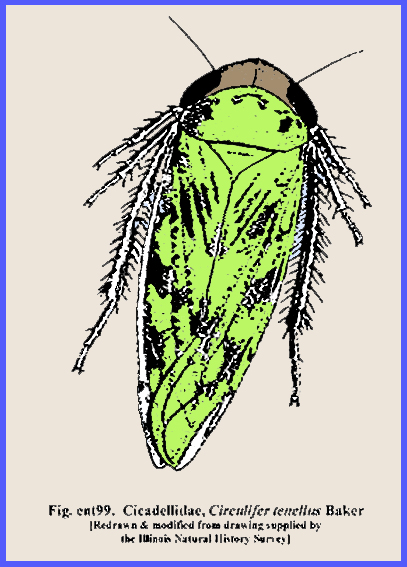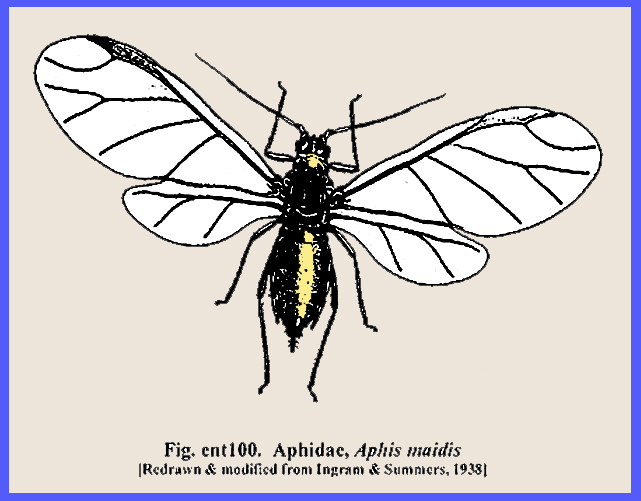File:
<homoptera.htm> : < (Entomology), (Invertebrates), (General
Index)> <Invertebrate Bibliography> <Glossary> <Site Description> <
Home>
|
Entomology: HOMOPTERA
1 Kingdom: Animalia, Phylum: Arthropoda Subphylum: Hexapoda: Class: Insecta: Order: Homoptera (Contact) Please CLICK on underlined
categories to view and on included illustrations to enlarge: Depress
Ctrl/F to search for subject matter:
The Homoptera includes a large number of different forms
ranging in size from the usually microscopic Coccidae to the large tropical
lantern bugs (Fulgoridae) and the cicadas, which may attain 5 cm. In length
and with a wing expanse of 10 cm. With the cicadas are the leafhoppers,
treehoppers and froghoppers, all active insects. DNA evidence shows a close relationship to the Hemiptera, so
that eventually the Homoptera may be once again grouped together with the
Hemiptera as they have been under Heteroptera earlier. Sometimes the life cycle may be
greatly prolonged, Cicada septendecim, ie., having a 17-year cycle.
The eggs are injected into holes in twigs of trees, and the nymphs hatching
from them fall to the ground into which they burrow to feed on the roots.
After about 17 years of nymphal growth a stage resembling a pupa is passed
through before emergence of the adult (derived and updated from
Borradaile & Potts, 1958).
Commerce
and Aspidiotus perniciosus the San
Jose scale insect that attacks citrus trees.
In the Coccidae the reproductive
phenomena are of much economic importance. A comparatively simple life cycle
is that of Aphis rumicis. The winter is passed on the spindle tree Euonymus
as eggs, which are laid in the autumn by fertilized females. In spring
these eggs give rise to wingless viviparous parthenogenetic females. A
variable number of these parthenogenetic generations is passed through in the
summer, then winged parthenogenetic females appear that migrate to another
host plant (the bean Vicia or other plants) and there reproduce,
giving rise to generations of parthenogenetic females which eventually
produce winged females that return to the primary host plant Euonymus. From
these there now appear oviparous females to copulate with winged males, that
are migrants from the secondary host plant, the bean. The life cycles are complex. Fertilized eggs are laid in autumn that
give rise to wingless viviparous parthenogenetic females. These then give rise to winged migrant
parthenogenetic females and wingless parthenogenetic viviparous females. Some of these give rise to winged
viviparous females that in turn give rise to wingless oviparous females. Others give rise to winged males that mate
with the wingless oviparous females.
Eggs are laid in the autumn.
The cyclical reproductive
phenomena in aphids leads to important questions relating to the differences
between sexual and parthenogenetic individuals, and to the environmental conditions
determining the occurrence of these phases in any life cycle.
------------------------------------------ All Homoptera are exclusively
plant feeders and some species have been used in the biological control of
weeds. They have membranous or
leathery wings, but it is possible to trace venation to the base. Apterous forms are also present. The mouthparts are beak-like and appear to
arise from the front legs. Two large groups of Homoptera are
(1) the cicadas and leafhoppers, and (2) the aphids, scale insects and
mealybugs. The size ranges from very
minute to larger forms. There are a
great variety of habits although they are all plant feeding. The cicada has the longest life cycle of
any insect, and there is a great diversity in dwelling places. ------------------------------------------ Cicadidae.
-- The cicadas
are noted for their
high-pitched call, which is made only by the male and is used to attract
females. The different species may be
recognized by this call. All cicadas
have a rather broad head and prominent eyes with three glossy, beadlike
ocelli between. The nymphs are underground
feeders. They possess enlarged front
legs for digging and may remain up to 17 years underground (= 17-year
locust). The last nymphal stage leaves the
ground. Adults are the largest of
Homoptera and do serious damage to trees by boring into them to lay their
eggs. ------------------------------------------ Membracidae. -- The head of treehoppers is
situated below the pronotum and covers most of the wing. Hook-like projections occur only
in the larvae. They feed on
herbaceous plants and some species have different hosts in different parts of
the life cycle. For example, oak in
springtime, goldenrod in summer and oak again in autumn. These insects secrete very sugary, sweet
honeydew, which attracts ants. The Buffalo
Treehopper
is a notorious pest that
causes damage to plants with its oviposition activity. It feeds on cover crops in orchards and
then lays eggs in trees. ------------------------------------------ Cercopidae. -- The immatures of spittle
insects
or froghoppers have
a protective froth covering of spittle, which prevents desiccation. Some species even construct a tube of
spittle. Mucus-like secretions
derived from special glands cause the froth.
This is beat up and mixed with air by action of the hind legs. It consists of water, anal fluid and air. These insects become free living
as adults when they resemble some leafhoppers very closely, but can be
distinguished by having spines on the apex of the hind tibia.. The adult is generally brownish or dark in
color. Some species show a pattern of
colors. Sometimes there are up to
eight different forms in the same species. ------------------------------------------ Cicadellidae. -- Leafhoppers feed
on plants in all stages and many are very economically important pests. These
insects are characterized by long, slender wings, which are held roof-like
above their body. They are very active as jumpers
due to their enlarged tibia, and the nymphs are agile and can run sideways.
The hind legs have a double row of spines and not a single circular row as in
spittlebugs. Some species are
brilliantly colored. Some leafhoppers are serious plant
virus vectors, which have a virus
incubation period that can last a year or more. The beet leafhopper migrates
and transmits Curly Top Virus
in North America They can also cause plant disease by their feeding
secretions. Potato
yellow leaf
or Hopperburn is
caused by the toxic effect due to the feeding of leafhoppers. In alfalfa the disease is termed
yellows. The toxic effect is not only
from their saliva but also due to their feeding on the vascular parts of
plants (xylem and phloem). They can
cause white mottling on beans. The potato
leafhopper
that causes all the
symptoms noted above migrates to higher latitudes annually. ------------------------------------------ Aphidae.
-- Aphids reproduce in large numbers. They have complex life histories with
winged and wingless forms and one or more hosts. They prefer to feed mostly on tender shoots of rapidly growing
plants, but will also feed at other sites even on the roots. Besides causing direct injury to plants
some species are also able to transmit plant viruses, which occur on their
mouthparts as contaminants. Aphids possess cornicles that
emit glandular secretions and can serve as a kind of defense. The cornicles are useful in identification
because of their many different shapes. Aphids secret honeydew from the
anus. When dropping onto plants
various molds grow on it, which will damage plants. Ants will care for aphids and extract honeydew from them by
caressing them with their antennae.
Sometimes ants will carry aphids underground to overwinter. A typical life cycle is described
as follows: Winter is spent on eggs
on the winter host plant. In the
spring the eggs hatch to produce the stem mother. These mature without fertilization and reproduce. Usually they are apterous and will produce
apterous offspring parthenogenetically.
Winged forms are produced next, which fly to the alternate host
plant. If the winter host is a tree
the alternate host will often be an herbaceous plant. Wingless generations are produced. If conditions become crowded on the
alternate host, winged generations may be produced, which are all
females. These fly to another plant
that may be the same or a different species of herbaceous plant. In the autumn, there is a migration back
to the winter host plant. Also, some
males may be produced on the summer host.
Also in autumn the female may produce several generations on the
reinvaded winter host. She may mate
with the male and then go through an egg-laying phase that overwinters. ------------------------------------------ Coccidae.
-- Scale insects are primarily tropical and
subtropical insects that secrete a wax covering over their body, which
protects them from external environmental conditions. Three groups of scales are (1) hard
scales, (2) soft
scales
and (3) mealybugs. Only a few males are produced and
the life cycle is quite complicated.
Scale insects have great economic importance as pests, especially on
tree crops. However, the lack insect
of India and the cochineal insect of Mexico have been favored commercially. The Biblical "manna"
is attributed to this family. A typical life history is as
follows: In springtime the eggs hatch
and the crawlers, which look like aphids, spread over the plants. The scale stage occurs primarily during
summer. In autumn and winter a mass
of eggs forms in place of a degenerated female. Overwintering occurs as eggs underneath the scale. Most species are parthenogenetic, but if
males are present they possess only one pair of hind wings. ------------------------------------------ Phylloxeridae.
-- Members of this family almost ruined the wine industry in
Europe in the late 17th Century. They
feed on the roots of plants.
Rootstock from America was grafted onto European grapes and stopped
the seriousness of the attack. ------------------------------------------ The invertebrates that transmit
virus diseases resembling viruses are primarily Homoptera, Acarina (excluding
spider mites), Thysanoptera and some Orthoptera, Hemiptera and
Coleoptera. Insects are the most
important vectors, but some viruses are also transmitted through vegetative
propagation and seed. A plant usually does not recover
once it contracts a virus. One vector
is sufficient to infest a plant so that the number of vectors is not
important. Viruses multiply within
plant tissue, and symptoms are similar to genetic disorders. Two types of viruses are (1)
Nonpersistant and (2) Persistant. A nonpersistant
virus
lives in the insect only a
short time. Aphids are usually
involved as well as herbaceous plants.
There is little or no latent period and mechanical transmission is
very effective. Persistant
viruses
may live in an insect
vector for its entire lifetime.
Leafhoppers are usually involved as well as woody plants. There is a definite latent period and
mechanical transmission is rare. The number of viruses that can be
transmitted by an insect may be large.
The green peach aphid is able to transmit over 50 species of virus all
of which are of the nonpersistant type.
Some viruses show symptoms in only a few plants while still having a
wide host range. Certain woody plants
show symptoms only after three years of initial inoculation (see <efl5.htm>. Producing resistant plant
varieties may control plant viruses.
The removal of diseased plants through rogueing is effective, which
eliminates the source of virus inoculum from the area. Controlling the insect vector with
pesticides is another approach, but it requires great thoroughness as only
one individual insect can still transmit the virus. Providing a host-free cycle in fields is sometimes effective as
well as heat treatment of seed that may be infected. Reducing weeds around a field can
eliminate hideaways for vectors. Some examples of serious virus
diseases are Tobacco Mosaic, Cucumber Mosaic, Potato Leaf Roll, Curly Top of
Beets and Peach Mosaic. An example of complete recovery
from a virus that is transmitted by leafhoppers is the Oleander Virus that
was beginning to destroy plants in California in the latter 20th Century,
especially those of with white blooms.
After about 10 years of rapid spread and infection, the plants began
to show recovery, so that by 2010 most show no symptoms whatsoever over a
wide area. ------------------------------------- Homoptera
--Biological Control Projects (50.5% of total projects) CLICK to View
============== |










